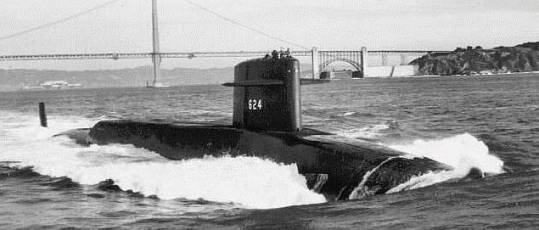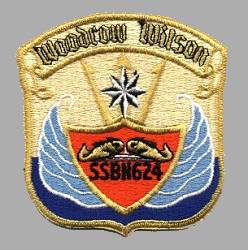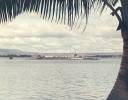

 |
Search the Site with

|
 |  |
USS WOODROW WILSON was the seventh LAFAYETTE - class nuclear powered fleet ballistic missile submarine and the first ship in the Navy to bear the name.
Deactivated while still in commission on January 11, 1993, the WOODROW WILSON was both decommissioned and stricken from the Navy list on September 1, 1994. She entered the Navy’s Nuclear Powered Ship and Submarine Recycling Program at Bremerton, Washington on September 26, 1997, and finished it on October 27, 1998. When she emerged from the program, the former ballistic missile submarine no longer existed as a complete ship and was classed as scrapped.
| General Characteristics: | Awarded: February 9, 1961 |
| Keel laid: September 13, 1961 | |
| Launched: February 22, 1963 | |
| Commissioned: December 27, 1963 | |
| Decommissioned: September 1, 1994 | |
| Builder: Mare Island Naval Shipyard, Vallejo, Calif. | |
| Propulsion system: one S5W nuclear reactor | |
| Propellers: one | |
| Length: 425 feet (129.6 meters) | |
| Beam: 33 feet (10 meters) | |
| Draft: 31.5 feet (9.6 meters) | |
| Displacement: Surfaced: approx. 7,250 tons; Submerged: approx. 8,250 tons | |
| Speed: Surfaced: 16 - 20 knots;Submerged: 22 - 25 knots | |
| Armament: 16 vertical tubes for Polaris or Poseidon missiles, four 21" torpedo tubes for | |
| Crew: 13 Officers and 130 Enlisted (two crews) |
Crew List:
This section contains the names of sailors who served aboard USS WOODROW WILSON. It is no official listing but contains the names of sailors who submitted their information.
Accidents aboard USS WOODROW WILSON:
| Date | Where | Events |
|---|---|---|
| May 8, 1963 | Mare Island Naval Shipyard, Vallejo, Calif. | USS WOODROW WILSON suffers a fire while under construction at Mare Island, injuring three. The fire causes only minor damage to the WOODROW WILSON and occures when a heavy cable comes in contact with a switchboard on the submarine. |
| June 4, 1979 | Race Rock, Atlantic | USS WOODROW WILSON runs aground in heavy fog at Race Rock while en route to New London, CT. The submarine backs off and proceeds to port for inspection and damage assessment. |
About the Ship's Name:
Thomas Woodrow Wilson - born on 28 December 1856 at Staunton, Va. - graduated from Princeton University in 1879 before attending University of Virginia Law School. He subsequently earned a doctorate at Johns Hopkins and then taught at Bryn Mawr and Wesleyan before accepting a teaching post at Princeton, his alma mater. He became president of Princeton in 1902 and brought the university to national prominence. In 1910, Wilson was elected governor of New Jersey and served a two-year term in which he effected several key progressive reforms.
After becoming the Democratic Party’s presidential candidate in the 1912 elections, Wilson defeated a badly split Republican Party and was inaugurated president on 4 March 1913. Wilson’s first term in the White House was marked by liberal reforms which were popularized under the label, the “New Freedom.” Upon the outbreak of World War I in Europe, Wilson tried to keep the United States neutral. While patiently insisting on American rights as a neutral, he successfully guided the country through the liner LUSITANIA crisis in the spring of 1915.
While abstaining from intervention in Europe’s affairs for a time, the United States, under Wilson’s leadership, moved decisively in Latin America and the Caribbean when it saw American rights threatened. American naval or military units landed in Mexico, Santo Domingo, Haiti, and Nicaragua to restore order and to establish benevolent American protection for its own nationals as well as for the nationals of the troubled countries.
Eventually, pressures to enter the war - despite the 1916 campaign slogan “He kept us out of war” - proved too great. In April 1917, the United States joined the Allied and Associated Powers in the war against the Central Powers. Exercising his powers as Commander in Chief, Wilson was well aware of the Navy’s role in the “war to end all wars” an “to make the world safe for democracy.” In a speech to the officers of the Atlantic Fleet on 11 August 1917, the President said: “...the officers of this Navy...have the distinction of saying how this war is going to be won.”
With the Navy guarding the sea lanes to Europe, the United States eventually sent substantial numbers of troops “over there”, to join the battle on the Western Front. On 11 November 1918, the armistice was signed, ending World War I.
Between 1914 and 1917, Wilson had based his appeals for peach upon the formula, “peace without victory.” After the United States entered the conflict, the President continued to strive for the ideal of a peace where in there would be no victor - none vanquished. Instead, he urged the recognition of the rights of smaller nations and freedom of the seas. His “Fourteen Points” attempted to apply these broad ideals to specific problem areas of the peaceful postwar settlement. Incorporating these fourteen points of international ethics into a comprehensive plan, Wilson broke precedent by leading the American delegation to the Peace Conference at Paris. Once there, however, he found to his dismay that European leaders were not as ready as he to make high ideals the foundation of a postwar settlement that would be fair and just for all. As a result, negotiations were weakened by many compromises with Wilson’s ideals, and the treaty, with its provision for a League of Nations, was rejected by the Republican-controlled Senate. Taking his fight to the people, Wilson embarked upon a strenuous speaking tour, valiantly fighting to convince the American people that only collective security could keep the United States out of future wars. In September 1919, worn out by the struggle for his League of Nations, Wilson broke physically, and remained ill throughout the remainder of his second term. Never fully recovered, he lived quietly in Washington after Warren G. Harding won the 1920 elections and brought “normalcy” to the United States; Wilson died in Washington on 3 February 1924.
USS WOODROW WILSON Image Gallery:
 |  |  |  |
 Back to Ballistic Submarines list.
Back to Ballistic Submarines list.  Back to ships list.
Back to ships list.  Back to selection page.
Back to selection page.  Back to 1st page.
Back to 1st page.